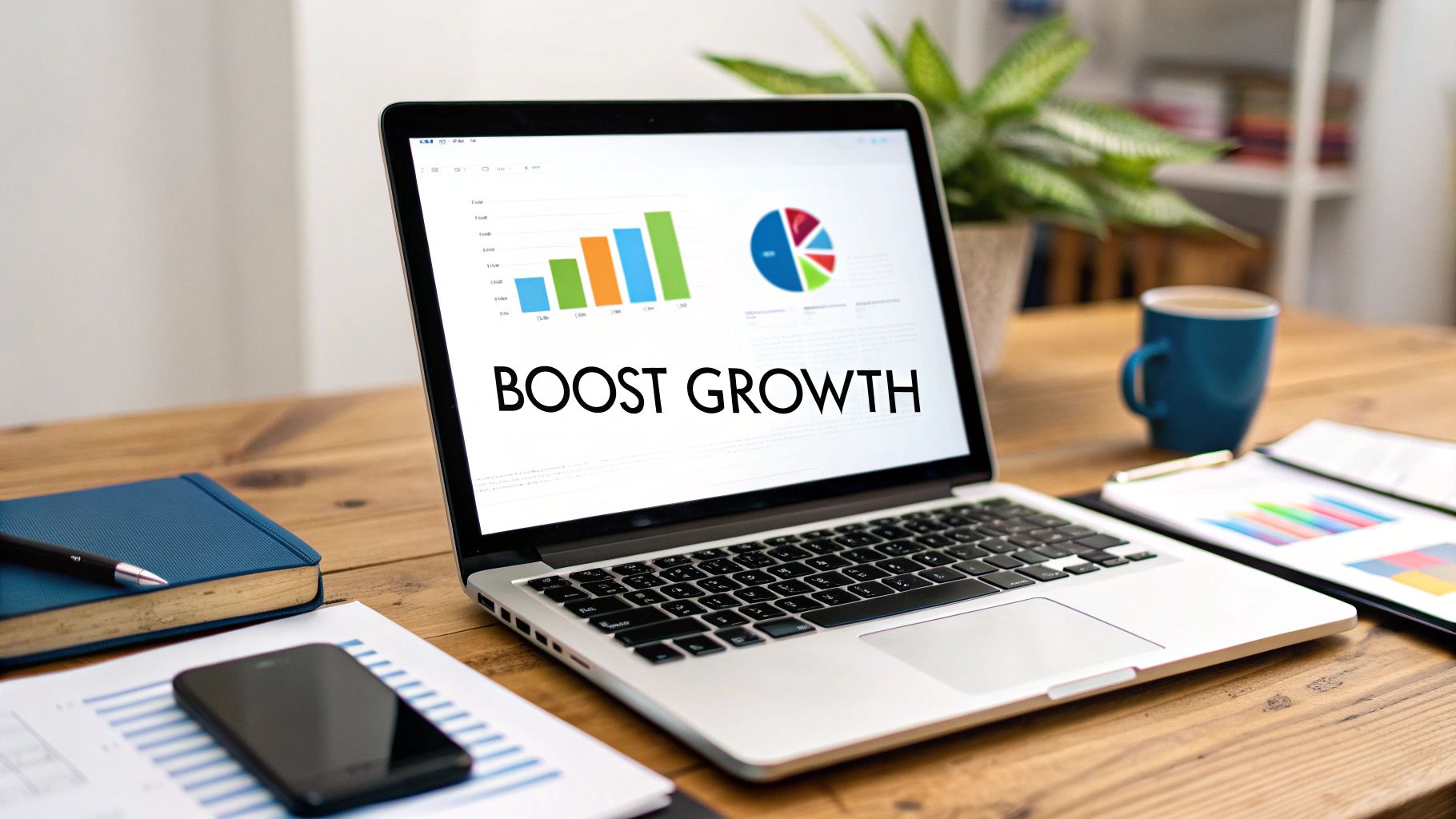Why Referral Programs Transform SaaS Growth Trajectories

Referral programs are more than just a passing marketing trend; they are a powerful tool for sustainable growth in the Software as a Service (SaaS) industry. Their effectiveness lies in the basic human tendency to trust recommendations from our personal networks. This word-of-mouth marketing is particularly impactful for SaaS products, often influencing buying decisions more effectively than traditional advertising. This makes referral programs ideally suited to the SaaS business model.
The Psychology of SaaS Referrals
Software can be complex, and users often need a level of trust before committing to a product. A recommendation from a trusted source lowers the barrier to entry considerably. SaaS businesses thrive on recurring revenue. A referred customer, having already been pre-qualified by someone they trust, is more likely to remain a subscriber, leading to a higher customer lifetime value. This is a stark contrast to customers acquired through less targeted marketing efforts.
The Value of Referred Customers
Referred customers are not only less expensive to acquire; they also possess inherent value. They convert at higher rates, demonstrate greater retention, and ultimately become more valuable advocates over time. This creates a snowball effect, driving exponential growth.
A prime example is Dropbox, which famously used its referral program to grow from 100,000 users to 4 million users in just 15 months. This remarkable growth was achieved by offering extra storage space to both the referrer and the new user, effectively transforming satisfied customers into enthusiastic brand ambassadors. Referral programs have proven remarkably effective for SaaS growth. Referred customers are roughly 4 times more likely to purchase than non-referred customers and boast a 37% higher retention rate. They are also worth approximately 16% more in lifetime value, showcasing significant long-term benefits.
This potent combination of higher conversion rates, improved retention, and increased lifetime value demonstrates why referral programs are such a cost-effective growth strategy. Learn more about SaaS referral program statistics. Referral marketing creates a win-win for both the company and its customer base. For further reading on effective referral programs, consider this resource: How to master referral marketing with winning examples.
Real-World SaaS Referral Success
Many SaaS companies have successfully transformed their growth trajectory using strategic referral programs. Effective programs are often seamlessly integrated into the user experience, offering rewards and incentives that align directly with customer needs. This proactive approach stands in contrast to less effective programs that are treated as an afterthought. Prioritizing the development and integration of a robust referral program is crucial for maximizing its impact on SaaS growth.
Building a Referral Program for SaaS That People Actually Use

Many SaaS referral programs fall short of their potential. They are often treated as an afterthought rather than a central growth driver. This section explores building a SaaS referral program that truly engages users and fosters sustainable growth. This includes understanding referral psychology, designing compelling incentives, and seamlessly integrating the program into the user experience.
Crafting Irresistible Incentives
Effective incentives are the foundation of any successful SaaS referral program. Surprisingly, the timing of a reward can be more influential than its size.
A smaller, instant reward upon referral signup can be more motivating than a larger, delayed one. This immediate gratification reinforces the desired behavior and encourages continued referrals.
Moreover, tailoring incentives to your customer base is crucial. Knowing what motivates your users, be it discounts, premium features, or exclusive content, is key to driving participation. This necessitates careful consideration of your target audience and their specific needs.
Reducing Friction Points
A smooth, user-friendly referral process is paramount. Any friction, like complex forms or unclear instructions, can discourage participation. Minimizing steps and simplifying sharing are vital for boosting referral rates.
Pre-populated referral links and easy social sharing options, for instance, can greatly enhance the user experience.
Messaging and Reward Structure
The psychology of effective messaging is crucial. Clear, concise, and compelling language that highlights benefits for both referrer and referred friend is key. This clarity builds trust and encourages referrals. For inspiration on crafting compelling messaging, explore resources like How to master your referral program with templates.
Finding the right balance between monetary and product-based rewards is also critical. While cash is appealing, product-based rewards like free upgrades or extended trials are often more effective for SaaS. These rewards directly connect to product value and encourage usage and engagement. Before choosing a reward structure, it's helpful to analyze different approaches. The following table offers a comparison:
Referral Reward Structures That Drive Results
Comparison of different reward structures and their effectiveness for various SaaS business models
| Incentive Type | Best For | Typical Conversion Rate | Implementation Complexity | Example Companies |
|---|---|---|---|---|
| Discount on subscription | Established businesses with high customer lifetime value | 2-5% | Low | HubSpot |
| Free month(s) of service | Freemium/low-cost SaaS | 5-10% | Low | Dropbox |
| Account credit | Transaction-based SaaS | 3-7% | Medium | PayPal |
| Early access to new features | Product-focused SaaS with active user base | 1-3% | Medium | Slack |
| Custom rewards (gift cards, merchandise) | Businesses with a strong brand identity | Varies | High | Spotify |
As shown above, different incentive types work best for different business models. Consider your target audience, product, and resources when choosing your reward structure.
Integration into User Experience
Successful companies embed referral mechanisms directly into their product. Instead of a separate initiative, they weave it into the user experience. This integration boosts visibility and encourages participation.
This could involve prominent placement in the user dashboard or automated prompts triggered by specific user actions. This proactive approach maximizes program visibility and reinforces its importance.
Measuring What Matters: SaaS Referral Program Metrics

Simply measuring sign-ups for your SaaS referral program isn't enough. Instead, focus on key performance indicators (KPIs) that truly indicate success. This involves understanding what drives program effectiveness and how to measure the real impact of referrals.
Beyond Participation Rate: Key Metrics for Referral Success
While participation rate seems important, it can be misleading. Many sign-ups don't translate into referrals. Users might sign up for the incentive without referring anyone. Focusing solely on participation creates an inaccurate view of your program's performance.
Prioritize referral conversion rate – the percentage of referred leads converting into paying customers. Also, consider the customer lifetime value (CLTV) of referred customers. This offers a more accurate measure of effectiveness.
Track the average revenue per referred user to quantify the financial impact of each referral. This metric directly links referrals to revenue generation.
Calculating Referral ROI and Leading Indicators
Calculating the return on investment (ROI) for your SaaS referral program goes beyond subtracting acquisition costs. Consider the long-term value of referred customers, including higher retention rates and increased CLTV.
These long-term factors significantly impact your referral program's profitability. For example, a 20% higher retention rate for referred customers generates substantial long-term savings and revenue growth.
Identifying leading indicators can predict future success. These might include active referrers, average referrals per referrer, and the conversion speed of referrals to paying customers.
Realistic Benchmarks and Tracking Systems
SaaS and digital goods sectors generally have high referral rates. The global average is about 2.35%, but software and digital goods often exceed this. This is likely due to network effects and the ease of sharing digital services. Find more detailed statistics here.
Understanding realistic benchmarks helps set achievable goals. Benchmarks vary by SaaS category and price. A low-priced, self-serve SaaS product might have a higher referral rate than a high-priced enterprise solution.
Implementing appropriate tracking systems is essential. These systems must capture the entire customer journey, from referral to conversion and beyond. This allows accurate revenue attribution to your referral program, demonstrating its value to stakeholders. Tools like Refgrow offer the necessary infrastructure for seamless tracking and accurate attribution.
Designing Your Referral Program For SaaS Success

A successful SaaS referral program requires a strategic design tailored to your business model and customer journey. This means understanding your customer segments, lifecycle stages, and crafting rewards that resonate while maintaining profitability.
Identifying Your Ideal Referrers
Not all customers are equal when it comes to referrals. Some segments are naturally more inclined to refer. Identify these power users by analyzing engagement, product usage, and satisfaction levels. These individuals are more likely to become valuable advocates for your product.
For example, customers frequently using advanced features or actively participating in your community forum are prime candidates.
Timing Is Everything: When To Introduce Your Program
Introducing your referral program at the right moment in the customer lifecycle is crucial. The ideal time is often after the customer has experienced the core value of your product.
This could be after successful onboarding, completing a key task, or achieving a specific milestone. This ensures a positive experience to share, increasing the likelihood of referrals.
Structuring Rewards: Balancing Generosity and Unit Economics
Reward structures must balance attractiveness with your business's financial health. Generous rewards can incentivize referrals, but they must align with your unit economics.
Overly generous rewards can erode profitability, while insufficient rewards won't motivate referrals. Finding the right balance is key.
Targeting Free Vs. Paying Users
A key decision is whether to initially target free or paying users. Free users offer a larger pool of potential referrers.
Paying users, however, are often more engaged and represent higher-quality referrals. The optimal approach depends on your business model and growth stage.
Seamless Integration Into Product Experience
Effective referral programs are seamlessly integrated into the product experience. They should be easily accessible within the user dashboard or triggered by relevant user actions.
A well-placed "Refer a Friend" button or an automated email after project completion can make a significant difference. For smooth integration, tools like Refgrow offer embeddable solutions.
Program Design Frameworks Based On Growth Stage
Tailor your program design to your company's growth stage. Early-stage startups might prioritize rapid user acquisition through generous incentives.
Established businesses might focus on maximizing customer lifetime value through targeted referrals. Flexibility is essential. A successful SaaS referral program constantly evolves alongside your business.
To help illustrate a structured approach, let's look at a sample launch plan.
The table below outlines a phased approach to implementing a successful SaaS referral program, highlighting key activities, team involvement, and success criteria at each stage.
| Timeline Stage | Key Activities | Team Involvement | Success Criteria |
|---|---|---|---|
| Phase 1: Planning & Setup (Weeks 1-4) | Define program goals, target audience, and reward structure. Choose a referral program software and integrate it with your platform. Develop marketing materials and communication plan. | Marketing, Product, Engineering | Finalized program details and integrated software. |
| Phase 2: Beta Launch (Weeks 5-8) | Invite a small group of power users to test the program and provide feedback. Monitor program performance and identify any issues. | Marketing, Customer Success | Gather user feedback and identify areas for improvement. Achieve a target referral rate within the beta group. |
| Phase 3: Full Launch (Weeks 9-12) | Officially launch the program to all users. Promote the program through various channels (email, in-app messages, social media). Track key metrics and make adjustments as needed. | Marketing, Sales, Customer Success | Increase overall referral rate and customer acquisition. Achieve a target ROI for the program. |
| Phase 4: Optimization & Growth (Ongoing) | Continuously analyze program performance and identify opportunities for optimization. Experiment with different reward structures, communication strategies, and targeting methods. | Marketing, Product | Sustained growth in referral rate and customer acquisition. Continuously improve program ROI. |
This phased approach allows for iterative improvements and adjustments based on data and feedback, ensuring your referral program effectively contributes to your SaaS success.
The Dollars and Sense: Financial Impact of Referral Programs
A well-structured referral program can significantly impact your SaaS bottom line. But to truly understand its potential, you need to go beyond basic metrics and dive into the economics. This means understanding the full cost structure and modeling the long-term financial benefits.
Calculating the Complete Cost Structure
Calculating your referral program's total cost involves factoring in several key expenses. These include the reward expenses paid to referrers, any platform fees associated with referral software like Refgrow, and the operational overhead to manage the program.
For example, if you offer a $50 credit for each successful referral and your platform fee is $1 per referral, your direct cost per acquisition is $51. However, this doesn't tell the whole story.
Also, consider the time your team spends on program administration, marketing, and support. These indirect costs, though often overlooked, contribute to the overall program expense. Accurately assessing these is vital for calculating true ROI.
Modeling Long-Term Financial Impact
The real power of a SaaS referral program lies in its long-term impact. Referred customers often have a higher customer lifetime value (CLTV) due to increased retention and lower churn.
This means a seemingly higher initial acquisition cost through referrals can actually yield greater profitability over time compared to other channels. Referred customers tend to stay longer and spend more. For further reading, check out this article: How to master your SaaS referral program.
Furthermore, a successful program accelerates growth velocity. As satisfied customers become advocates, they fuel organic growth, reducing your reliance on costly advertising and creating a sustainable acquisition engine. This organic growth can greatly impact your overall marketing budget. The SaaS affiliate and referral marketing ecosystem is a rapidly growing sector. The global affiliate marketing industry grew from $27.8 billion in 2023 to an estimated $32.3 billion in 2024, a CAGR of roughly 10%. SaaS-focused affiliate programs are among the most lucrative, with commissions ranging from 20% up to 70%. This high commission rate is fueled by the recurring revenue model of SaaS, where affiliates earn recurring commissions. The SaaS affiliate platform market is projected to maintain a robust CAGR of 15.6% from 2024 to 2028. This highlights the increasing importance of referral programs for SaaS growth. Explore this further here.
Building the Business Case and Ongoing Optimization
When presenting your referral program to stakeholders, emphasize the long-term financial benefits. Quantify the projected increase in CLTV, reduced churn, and accelerated growth. These data points demonstrate the true value of the program.
Finally, continuous optimization is essential. Regularly analyze your program's performance, experiment with different reward structures, and refine your messaging. This ensures your referral program remains a powerful engine for sustainable SaaS growth and financial success.
Troubleshooting Your SaaS Referral Program
A successful SaaS referral program requires more than just setting it up and forgetting about it. Even the most well-designed programs can hit some bumps in the road. This section explores common challenges and provides solutions that successful SaaS companies use to transform their referral programs into powerful growth engines.
Diagnosing Low Participation Rates
Low participation is a common hurdle. While incentives are important, a deeper look into the user experience is often needed. Is the referral process too complicated? Are the benefits clearly explained? Unclear instructions or a multi-step process can discourage even the most enthusiastic users.
Simplify the referral process and communicate the benefits clearly, making it as easy as possible for users to refer their friends. Consider a tool like Refgrow to streamline the process.
Combating Referral Fraud
Referral fraud, where users create fake accounts to earn rewards, can compromise a program's integrity. But overly strict anti-fraud measures can create friction for legitimate users. Finding the right balance is key.
Implement fraud detection mechanisms, but prioritize a positive user experience. Consider tiered rewards, where larger rewards are unlocked after a certain number of legitimate referrals. This encourages genuine referrals while minimizing fraudulent activity.
Revitalizing Stale Programs
Referral programs can lose steam over time. Re-engaging inactive advocates calls for a strategic approach. Refresh your messaging, highlighting new benefits or exclusive rewards for referrers.
Limited-time promotions can create a sense of urgency. Also, segment your audience and personalize your outreach. For example, offer customized rewards based on user behavior or past referrals. This targeted approach can rekindle interest and increase participation.
Maintaining Program Visibility Without Being Annoying
Maintaining visibility is crucial, but excessive promotion can backfire. Integrate subtle reminders within your product. Trigger prompts based on user actions, like completing a key task or reaching a milestone.
This contextual approach is less intrusive and more effective. Refgrow, with its seamless embeddable design, facilitates this subtle yet powerful integration.
Reactivating Dormant Advocates
Inactive referrers represent untapped potential. Identify these users and re-engage them with personalized messages. Offer exclusive incentives for making their first referral or highlight past successes.
This reminds them of the program’s value and encourages renewed participation.
Scaling Your Program as Your Customer Base Grows
As your customer base expands, so should your referral program. Automate processes, like reward distribution and fraud detection, for maximum efficiency. Implement robust tracking systems to monitor performance and identify areas for improvement.
Refgrow's scalable architecture and in-depth analytics allow you to manage and optimize your program as your business grows. Real SaaS companies have transformed underperforming referral programs into growth engines with these strategic adjustments. Ongoing optimization, rather than complete overhauls, is often the key to long-term success.
Ready to transform your SaaS growth with a powerful referral program? Refgrow provides a fully embeddable, customizable solution to help you acquire and retain more customers through referrals. Start growing with Refgrow today!

